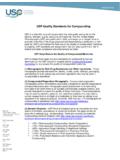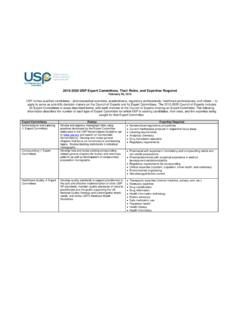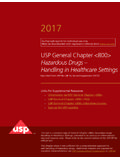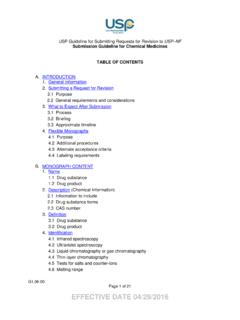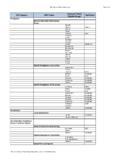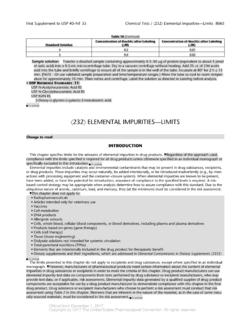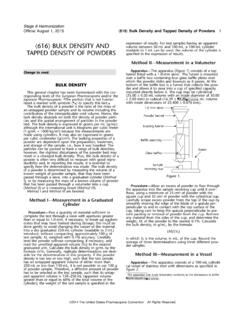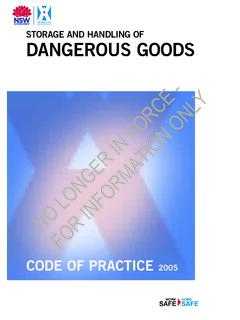Transcription of 2017 - United States Pharmacopeia
1 USP General Chapter <800> Hazardous Drugs Handling in Healthcare SettingsLinks For Supplemental Resources Information on USP General Chapter <800> USP General Chapter <800> FAQs USP General Chapter <800> Education Courses Sign up for USP updatesAuthorized reprint for individual use be downloaded with registration directly from text is a courtesy copy of General Chapter <800> Hazardous Drugs Handling in Healthcare Settings, intended to be used as an informational tool and resource only. Please refer to the current edition of the USP-NF for official chapter alone is not sufficient for a comprehensive approach to safe handling of hazardous drugs.
2 Additional chapters are required for complete implementation; see USP Compounding Compendium or from USP 40 NF 35, Second Supplement (2017)Add the following: 800 HAZARDOUS DRUGS HANDLING IN HEALTHCARE SETTINGS(Chapter to become official July 1, 2018.)1. INTRODUCTION AND SCOPEThis chapter describes practice and quality standards for handling hazardous drugs (HDs) to promote patient safety, workersafety, and environmental protection. Handling HDs includes, but is not limited to, the receipt, storage, compounding, dis-pensing, administration, and disposal of sterile and nonsterile products and chapter applies to all healthcare personnel who handle HD preparations and all entities that store, prepare, transport, oradminister HDs ( , pharmacies, hospitals and other healthcare institutions, patient treatment clinics, physicians' practice fa-cilities, or veterinarians' offices).
3 Personnel who may potentially be exposed to HDs include, but are not limited to: pharma-cists, pharmacy technicians, nurses, physicians, physician assistants, home healthcare workers, veterinarians, and that handle HDs must incorporate the standards in this chapter into their occupational safety plan. The entity'shealth and safety management system must, at a minimum, include: A list of HDs Facility and engineering controls Competent personnel Safe work practices Proper use of appropriate Personal Protective Equipment (PPE) Policies for HD waste segregation and disposalThe chapter is organized into the following main sections:1.
4 Introduction and Scope2. List of Hazardous Drugs3. Types of Exposure4. Responsibilities of Personnel Handling Hazardous Drugs5. Facilities and Engineering Controls6. Environmental Quality and Control7. Personal Protective Equipment8. Hazard Communication Program9. Personnel Training10. Receiving11. Labeling, Packaging, Transport, and Disposal12. Dispensing Final Dosage Forms13. Compounding14. Administering15. Deactivating, Decontaminating, Cleaning, and Disinfecting16. Spill Control17. Documentation and Standard Operating Procedures18. Medical SurveillanceGlossaryAppendicesAppendix 1: AcronymsAppendix 2: Examples of Designs for Hazardous Drug Compounding AreasAppendix 3: Types of Biological Safety CabinetsReferences2.
5 LIST OF HAZARDOUS DRUGSThe National Institute for occupational Safety and Health (NIOSH) maintains a list of antineoplastic and other HDs used inhealthcare. An entity must maintain a list of HDs, which must include any items on the current NIOSH list that the entity han-dles. The entity's list must be reviewed at least every 12 months. Whenever a new agent or dosage form is used, it should bereviewed against the entity's NIOSH list of antineoplastic and other HDs provides the criteria used to identify HDs. These criteria must be used toidentify HDs that enter the market after the most recent version of the NIOSH list, or that the entity handles as an investiga-Errata to First Supplement to USP 40 NF 35 Physical Tests / 800 Hazardous Drugs 1 Official from December 1, 2017 Copyright (c) 2017 The United States Pharmacopeial Convention.
6 All rights from by uspstaff on Tue Sep 19 09:21:47 EDT 2017 Refer to USP Notice of Intent to Revise (9/29/2017)Authorized reprint for individual use only. Must be downloaded with registration directly from drug. If the information available on a drug is deemed insufficient to make an informed decision, consider the drug haz-ardous until more information is 1: Containment Requirements Drugs on the NIOSH list that must follow the requirements in this chapter include: Any HD API Any antineoplastic requiring HD manipulation Drugs on the NIOSH list that do not have to follow all the containment requirements of this chapter if an assessment of risk is performed andimplemented include.
7 Final dosage forms of compounded HD preparations and conventionally manufactured HD products, including antineoplastic dosageforms that do not require any further manipulation other than counting or repackaging (unless required by the manufacturer) For dosage forms of other HDs on the NIOSH list, the entity may perform an assessment of risk to determine alternative containment strategiesand/work practicesSome dosage forms of drugs defined as hazardous may not pose a significant risk of direct occupational exposure because oftheir dosage formulation ( , tablets or capsules solid, intact medications that are administered to patients without modify-ing the formulation).
8 However, dust from tablets and capsules may present a risk of exposure by skin contact and/or inhala-tion. An assessment of risk may be performed for these dosage forms to determine alternative containment strategies and/orwork practices. If an assessment of risk is not performed, all HDs must be handled with all containment strategies defined inthis assessment of risk must, at a minimum, consider the following: Type of HD ( , antineoplastic, non-antineoplastic, reproductive risk only) Dosage form Risk of exposure Packaging ManipulationIf an assessment of risk approach is taken, the entity must document what alternative containment strategies and/or workpractices are being employed for specific dosage forms to minimize occupational exposure.
9 If used, the assessment of risk mustbe reviewed at least every 12 months and the review TYPES OF EXPOSURER outes of unintentional entry of HDs into the body include dermal and mucosal absorption, inhalation, injection, and inges-tion ( , contaminated foodstuffs, spills, or mouth contact with contaminated hands). Containers of HDs have been shownto be contaminated upon receipt. Both clinical and nonclinical personnel may be exposed to HDs when they handle HDs ortouch contaminated surfaces. Table 1 lists examples of potential routes of exposure based on 1.
10 Examples of Potential Opportunities of Exposure Based on ActivityActivityPotential Opportunity of ExposureReceipt Contacting HD residues present on drug containers, individual dosage units, outer containers, work surfaces, orfloorsDispensing Counting or repackaging tablets and capsulesCompounding and othermanipulations Crushing or splitting tablets or opening capsules Pouring oral or topical liquids from one container to another Weighing or mixing components Constituting or reconstituting powdered or lyophilized HDs Withdrawing or diluting injectable HDs from parenteral containers Expelling air or HDs from syringes Contacting HD residue present on PPE or other garments Deactivating, decontaminating, cleaning.
